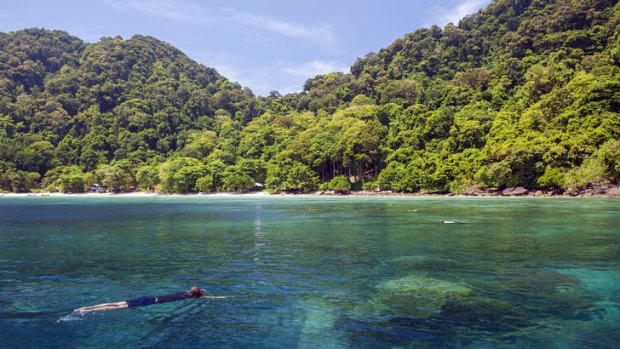
Snorkelling at Pulau Tenggol.Credit: Leisa Tyler
Exploring the country by car affords Leisa Tyler opportunities for adventure and taste treats galore.
A thumb of land falling off southern Thailand, Peninsular Malaysia offers a bit of everything: heritage towns, temperate highlands, cities, long, sparkling white beaches (with nobody on them), vibrant coral reefs and, arguably, the best and most diverse cuisine in Asia.
All this can be experienced on a self-drive tour. Malaysia has excellent roads and cheap-as-chips petrol (about 1.90 ringgit, or 65¢ a litre). And with left-hand driving and a mostly English-speaking population, it's ideal for Australians.
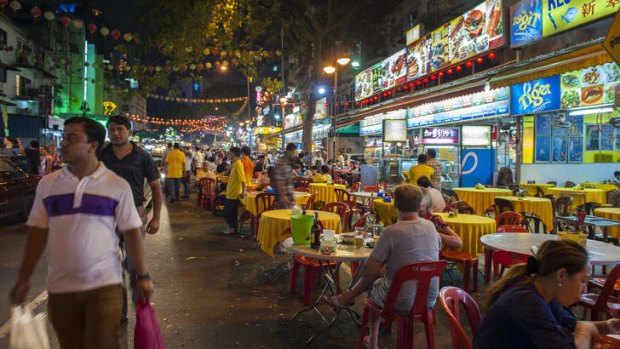
Street food night market on Jalan Alor in Kuala Lumpur.Credit: Leisa Tyler
A note of caution: although Malaysia's roads are first-rate, some of its drivers are on the verge of neurotic, with the occasional one being positively mad. Tailgating is a national sport and few use their indicators. They change lanes at whim and if there's a jam, they just drive on the inside and then beep profusely until they're let back in.
AIRPORT TO MALACCA
It's an easy 90-minute run south from Kuala Lumpur International Airport to Malacca, the World Heritage-listed settlement of rickety churches and rows of Chinese shop houses that flank the Straits of Malacca.
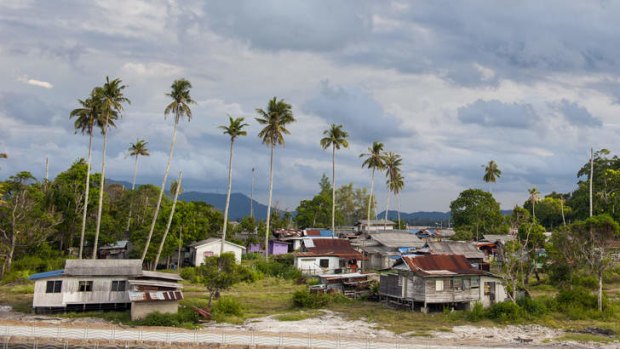
A fishing village near Dungun.Credit: Leisa Tyler
Conquered by the Portuguese in 1511, Malacca had two more European powers pass through its winding streets before it was handed back to the Malays in 1957, namely the Dutch and the British.
All had a hand in the town's architecture. My husband and I soak it up by checking into the British-era 1920s Chinese mansion of the Majestic Hotel (majesticmalacca.com; from 452 ringgit a night). It has hand-painted tile floors and wicker chairs in the lobby, and reproduction four-poster beds and claw-foot bath tubs in the guest rooms, which are in a newly built tower.
We then head out for a walk, tracing the flower-lined canal to Malacca's most notable building, the auburn-red Stadthuys, built in 1650 as the residence of the Dutch governor. Originally white and built with bricks from Holland, the Stadthuys was apparently repainted to conceal the stains of betel nuts spat on the walls.
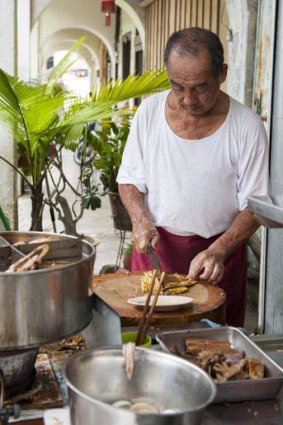
A vendor preparing food at Tai Buan in Penang.Credit: Leisa Tyler
From here, it's a short stroll to St Paul's Church, which once held the body of Catholic saint and missionary Francis Xavier in one direction and Jonker Street and its colourful Chinese shop-houses, now filled with cafes and galleries, in the other.
TO KUANTAN
Leaving Malacca, we head inland for a five-hour drive through Peninsular Malaysia's lush interior. Most of the country's primordial jungles have been replaced by palm plantations, whose bright-red fruits are crushed for oil. This is what greets us now: kilometre after kilometre of palms spread like a giant blanket across the land.
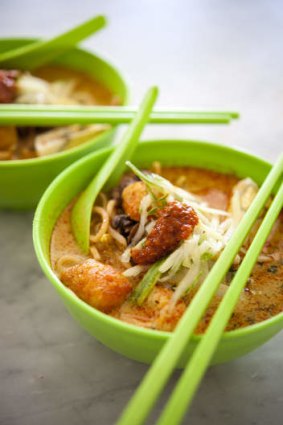
Laksa in Malacca.Credit: Leisa Tyler
It's quite a different story on the east coast, on Malaysia's predominantly Muslim Malay-inhabited seashore, which boasts some of the most beautiful and untouched beaches in Asia. Our first seaside encounter is at Kuantan, the capital of Pahang and a sleepy coastal town midway up the land mass. While the town is nondescript, the beach is stunning: a crescent-moon bay of milky-blue water and powdery-white sands jutting up to sunburnt boulders and lush tangles of rainforest.
The sprawling, 330-room, two-pool Hyatt Regency (kuantan.regency.hyatt.com; from 383 ringgit ) is the only hotel with direct access to the beach. It's friendly and laid-back, but lovers of peace should avoid weekends, when it becomes a heaving jumble of raucous children.
TO DUNGUN
We take the coastal road north to the state of Terengganu, past belching factories and the super-size Petronas oil refinery to Dungun, a small fishing town straddling the mouth of the Sungai Dungun river.
Here we check into the Tanjong Jara Resort (tanjongjararesort.com; from 812 ringgit, including breakfast), which is a swath of ponds, pools, gardens and 99 huge guest rooms that open to an impossibly beautiful stretch of snow-white sand and crystal-clear water. The best bit: there is nobody else for miles.
Tanjong Jara's other strong point is its food - specifically, the local food, which has close ties to neighbouring Thailand. It includes quickly cooked curries, a liberal use of lemon grass and sweeter tastes than the Malay, Hokkien Chinese and southern Indian flavours popular in Malaysian cuisine. Don't miss the local specialty - a rather wicked fish sausage called keropok lekor served with chilli sauce.
The kitchen is overseen by Anne, a vivacious chef with a penchant for using ingredients found in the market that day. We join her on a trip to the market to buy cashews in their shells, snapper freshly plucked from the sea and leafy vegetables, then delve into her "a bit of this and a bit of that" cooking class.
Just don't miss a snorkelling trip to Pulau Tenggol, an idyllic island off the coast with a stunning white-sand cove and shallow waters teeming with multicoloured fish and adolescent turtles walloping in the bay.
TO PENANG
It's a 10-hour drive from Dungun to the island of Penang on the west coast, which we start by skirting the seaside before winding up through the Titiwangsa Mountains, where dusky-blue peaks are an outpost for the rare tiger and wild elephants. If in doubt, shorten the drive with an overnight in Kota Bharu. A clutch of roadside restaurants serve rice with Malay curries. Luckily, Penang has some of the best food in Asia.
Established in 1786 as a port and administrative centre by the British East India Company, Penang's main town, World Heritage-listed George Town, bursts with colonial-era architecture: majestic Victorian- era government buildings and rows of candy-coloured shop houses that have been turned into hotels, galleries and cafes.
We check into Straits Collection (straitscollection.com.my; from 450 ringgit), four smart, two-storey apartments in a row of old terrace houses on Armenian Street, which is owned and run by Australian Narelle McMurtrie, before heading out to eat.
The choices are plentiful: turn right for Little India and its crepe-like dosas and coconut-based curries that hail in from Tamil Nadu, or turn left for five-spiced meats and tamarind-based soups from the town's Hokkien Chinese.
TO CAMERON HIGHLANDS
Driving off the island via the 13.5-kilometre bridge, we take the expressway south to the British colonial town of Ipoh, which was renowned for its tin-mining riches and is now a foodie heaven.
Like Penang, Ipoh's delights are countless, but it's hard to go past chicken rice, which is succulent boiled chicken served with plump bean sprouts and a slightly sweet soy sauce from Lou Wong (49 Jalan Yau Tet Shin; 23 ringgit for half a fowl). Leave room for a fresh silken tofu in syrup from Funny Mountain (49 Jalan Theatre, two ringgit).
It's a two-hour drive from Ipoh up through the mountains to the Cameron Highlands, a hill station where the British went to escape the heat, and which is now an industrial patchwork of flower and strawberry farms. We drive through the rubble to the town of Tanah Rata and the elegant Cameron Highlands Resort (cameronhighlandsresort.com; from 452 ringgit), with its log fires, waistcoated staff and huge bedrooms studded with reproduction four-poster beds, hardwood floors and french windows overlooking a golf course.
We arrive mid-afternoon for high tea, which is a three-tiered extravaganza with scones, cucumber sandwiches and local tea before a walk on tea company Boh's original estate, which is now a clutch of rusting sheds with superb views of hills lined with manicured tea bushes.
TO KUALA LUMPUR
We turn right out of the resort and follow the meandering road through dense jungle and rejoin the highway at Tapah. From here, it's a straight run to bustling Kuala Lumpur and our hotel, the snazzy new Grand Hyatt (kualalumpur.grand.hyatt.com; from 592 ringgit).
The newest bolthole in town, the Grand Hyatt has 412 rooms of marble, plush beige-and-grey tones and a clever bathroom design, with a separate vanity, make-up corner, toilet, walk-in dresser, bath and shower.
It's wise to avoid peak hour and arrive before 5pm, which allows enough time to chill by the pool before indulging in a well-deserved glass of bubbly at the hotel's Club Lounge.
Hyatt's Thirty8 restaurant, with its awe-inspiring 360-degree views over the city, is the cool cat of Kuala Lumpur's dining scene. It's a culinary United Nations, with sushi in one corner and steak in another.
For some street action, take the elevated walkway to Jalan Alor, where a clutch of stalls offer everything from satay to grilled fish and piquant spicy salads for a few dollars a plate.
The writer was a guest of the featured hotels.
TRIP NOTES
MORE INFORMATION
GETTING THERE
Malaysia Airlines has a fare to KL for about $740 low-season return from Sydney and Melbourne. See malaysianairlines.com.
DRIVING THERE
Avis rents cars by the week from 1100 ringgit ($375). See avis.com.
Sign up for the Traveller Deals newsletter
Get exclusive travel deals delivered straight to your inbox. Sign up now.